Behavioural Analysis Project: Applying Theories to a Personal Event
VerifiedAdded on 2023/05/31
|7
|1798
|320
Report
AI Summary
This report presents a behavioural analysis project reflecting on a past event and applying management theories learned in class. The author reflects on a corporate function failure at XYZ Ltd, drawing parallels to cases in the 'Ropes' book and utilizing management theories such as stress management, leadership (specifically the great man theory), and conflict resolution. The report discusses how communication issues and a lack of clear direction contributed to the event's failure, and how leadership skills and conflict management strategies were employed to address these issues. The author concludes by emphasizing the importance of proactively implementing management theories in future organizational programs to avoid similar failures, and highlights the value of open communication and inclusive decision-making processes. The document / assignment is contributed by a student to be published on the website Desklib. Desklib is a platform which provides all the necessary AI based study tools for students.

Running head: BEHAVIOURAL ANALYSIS PROJECT
Behavioural Analysis Project
Name of the Student
Name of the University
Author’s Note:
Behavioural Analysis Project
Name of the Student
Name of the University
Author’s Note:
Paraphrase This Document
Need a fresh take? Get an instant paraphrase of this document with our AI Paraphraser
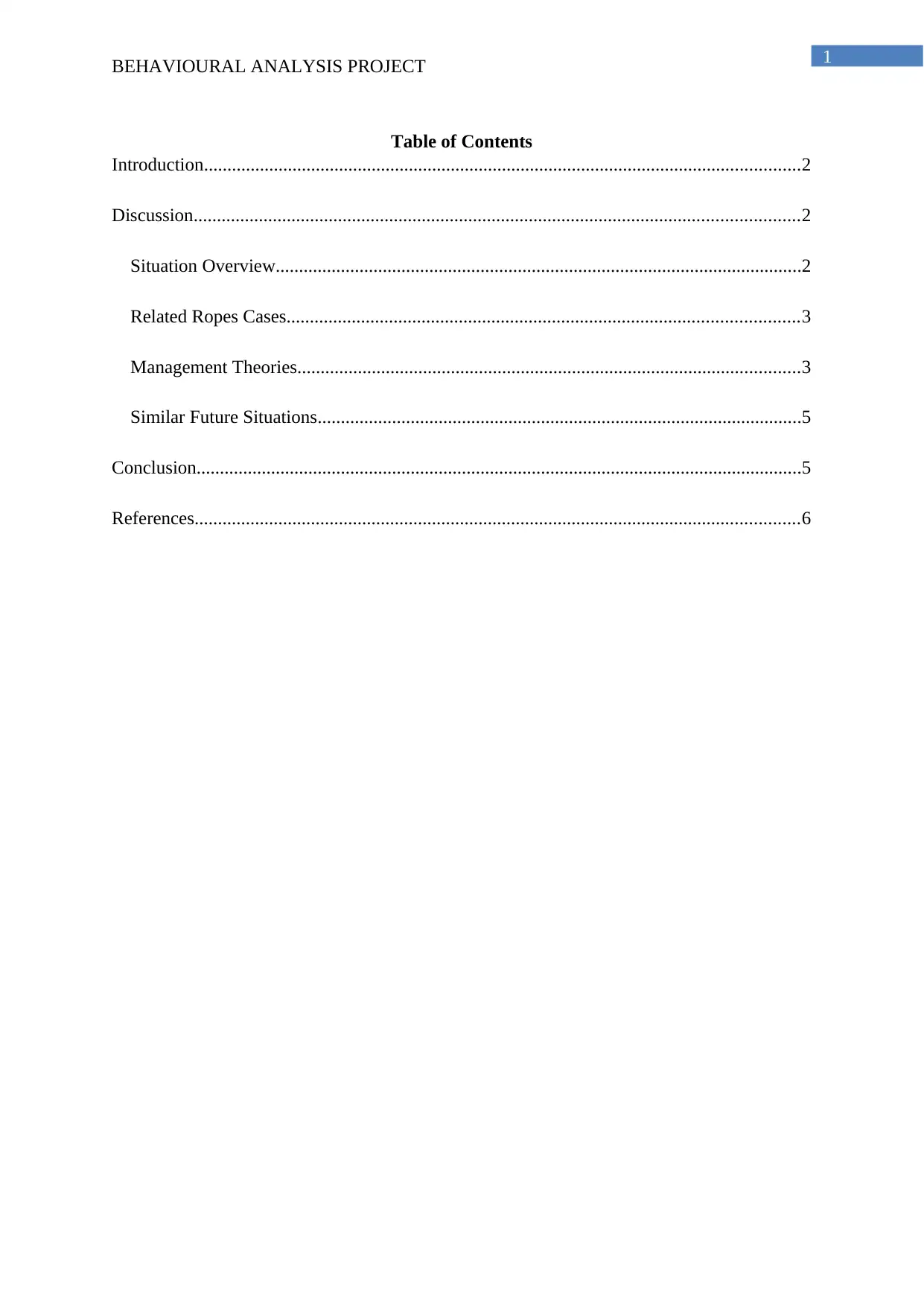
1
BEHAVIOURAL ANALYSIS PROJECT
Table of Contents
Introduction................................................................................................................................2
Discussion..................................................................................................................................2
Situation Overview.................................................................................................................2
Related Ropes Cases..............................................................................................................3
Management Theories............................................................................................................3
Similar Future Situations........................................................................................................5
Conclusion..................................................................................................................................5
References..................................................................................................................................6
BEHAVIOURAL ANALYSIS PROJECT
Table of Contents
Introduction................................................................................................................................2
Discussion..................................................................................................................................2
Situation Overview.................................................................................................................2
Related Ropes Cases..............................................................................................................3
Management Theories............................................................................................................3
Similar Future Situations........................................................................................................5
Conclusion..................................................................................................................................5
References..................................................................................................................................6
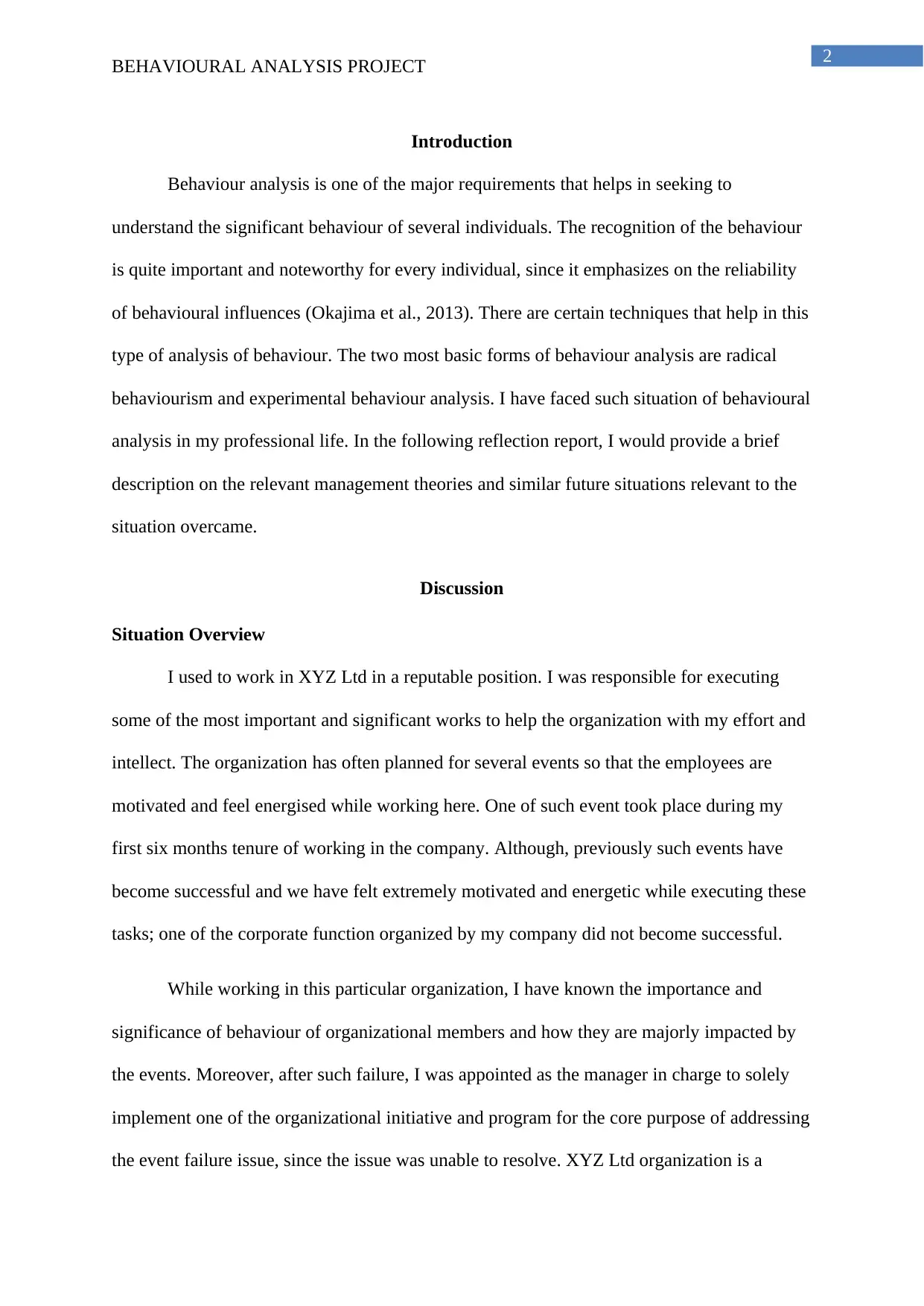
2
BEHAVIOURAL ANALYSIS PROJECT
Introduction
Behaviour analysis is one of the major requirements that helps in seeking to
understand the significant behaviour of several individuals. The recognition of the behaviour
is quite important and noteworthy for every individual, since it emphasizes on the reliability
of behavioural influences (Okajima et al., 2013). There are certain techniques that help in this
type of analysis of behaviour. The two most basic forms of behaviour analysis are radical
behaviourism and experimental behaviour analysis. I have faced such situation of behavioural
analysis in my professional life. In the following reflection report, I would provide a brief
description on the relevant management theories and similar future situations relevant to the
situation overcame.
Discussion
Situation Overview
I used to work in XYZ Ltd in a reputable position. I was responsible for executing
some of the most important and significant works to help the organization with my effort and
intellect. The organization has often planned for several events so that the employees are
motivated and feel energised while working here. One of such event took place during my
first six months tenure of working in the company. Although, previously such events have
become successful and we have felt extremely motivated and energetic while executing these
tasks; one of the corporate function organized by my company did not become successful.
While working in this particular organization, I have known the importance and
significance of behaviour of organizational members and how they are majorly impacted by
the events. Moreover, after such failure, I was appointed as the manager in charge to solely
implement one of the organizational initiative and program for the core purpose of addressing
the event failure issue, since the issue was unable to resolve. XYZ Ltd organization is a
BEHAVIOURAL ANALYSIS PROJECT
Introduction
Behaviour analysis is one of the major requirements that helps in seeking to
understand the significant behaviour of several individuals. The recognition of the behaviour
is quite important and noteworthy for every individual, since it emphasizes on the reliability
of behavioural influences (Okajima et al., 2013). There are certain techniques that help in this
type of analysis of behaviour. The two most basic forms of behaviour analysis are radical
behaviourism and experimental behaviour analysis. I have faced such situation of behavioural
analysis in my professional life. In the following reflection report, I would provide a brief
description on the relevant management theories and similar future situations relevant to the
situation overcame.
Discussion
Situation Overview
I used to work in XYZ Ltd in a reputable position. I was responsible for executing
some of the most important and significant works to help the organization with my effort and
intellect. The organization has often planned for several events so that the employees are
motivated and feel energised while working here. One of such event took place during my
first six months tenure of working in the company. Although, previously such events have
become successful and we have felt extremely motivated and energetic while executing these
tasks; one of the corporate function organized by my company did not become successful.
While working in this particular organization, I have known the importance and
significance of behaviour of organizational members and how they are majorly impacted by
the events. Moreover, after such failure, I was appointed as the manager in charge to solely
implement one of the organizational initiative and program for the core purpose of addressing
the event failure issue, since the issue was unable to resolve. XYZ Ltd organization is a
⊘ This is a preview!⊘
Do you want full access?
Subscribe today to unlock all pages.

Trusted by 1+ million students worldwide
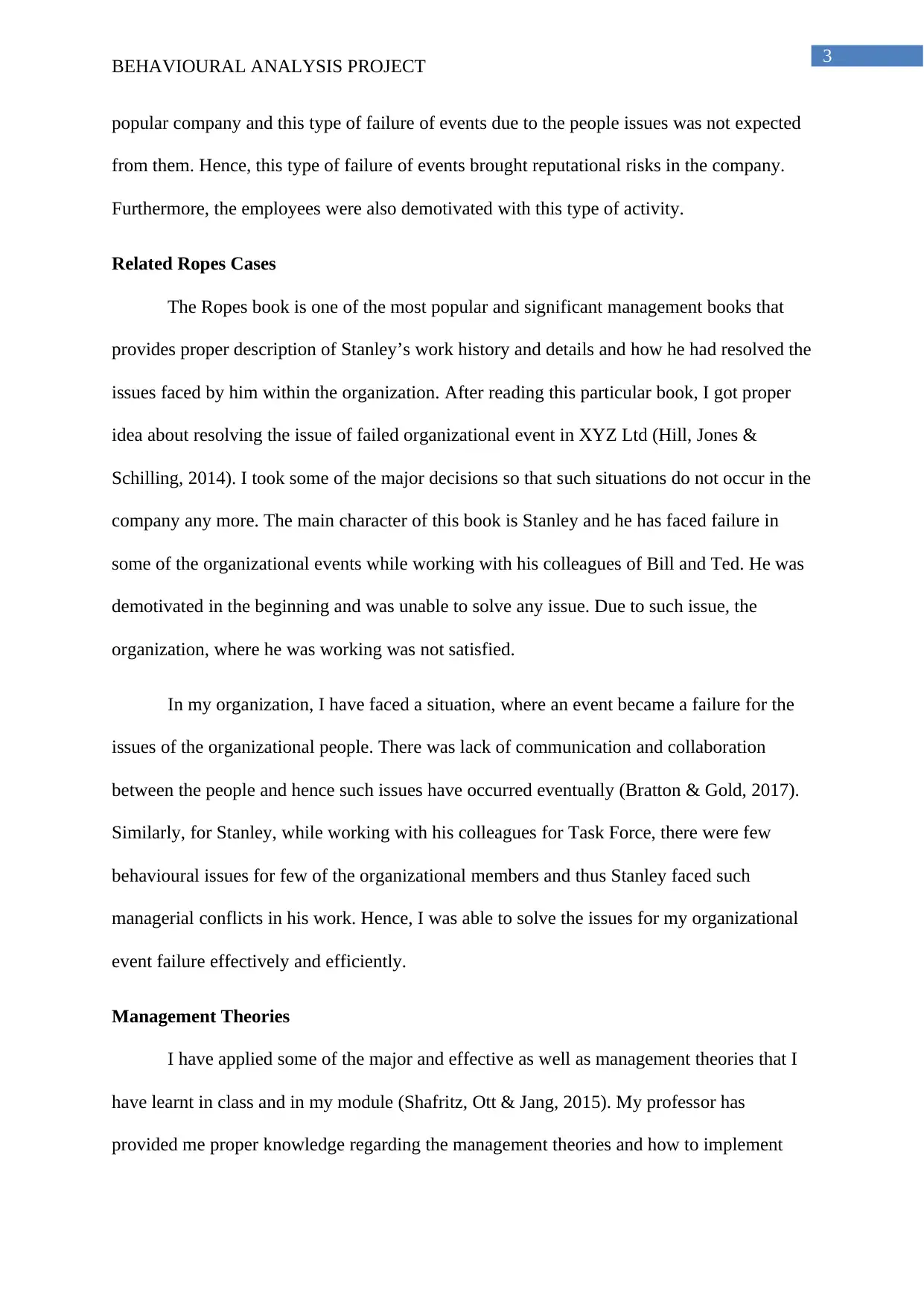
3
BEHAVIOURAL ANALYSIS PROJECT
popular company and this type of failure of events due to the people issues was not expected
from them. Hence, this type of failure of events brought reputational risks in the company.
Furthermore, the employees were also demotivated with this type of activity.
Related Ropes Cases
The Ropes book is one of the most popular and significant management books that
provides proper description of Stanley’s work history and details and how he had resolved the
issues faced by him within the organization. After reading this particular book, I got proper
idea about resolving the issue of failed organizational event in XYZ Ltd (Hill, Jones &
Schilling, 2014). I took some of the major decisions so that such situations do not occur in the
company any more. The main character of this book is Stanley and he has faced failure in
some of the organizational events while working with his colleagues of Bill and Ted. He was
demotivated in the beginning and was unable to solve any issue. Due to such issue, the
organization, where he was working was not satisfied.
In my organization, I have faced a situation, where an event became a failure for the
issues of the organizational people. There was lack of communication and collaboration
between the people and hence such issues have occurred eventually (Bratton & Gold, 2017).
Similarly, for Stanley, while working with his colleagues for Task Force, there were few
behavioural issues for few of the organizational members and thus Stanley faced such
managerial conflicts in his work. Hence, I was able to solve the issues for my organizational
event failure effectively and efficiently.
Management Theories
I have applied some of the major and effective as well as management theories that I
have learnt in class and in my module (Shafritz, Ott & Jang, 2015). My professor has
provided me proper knowledge regarding the management theories and how to implement
BEHAVIOURAL ANALYSIS PROJECT
popular company and this type of failure of events due to the people issues was not expected
from them. Hence, this type of failure of events brought reputational risks in the company.
Furthermore, the employees were also demotivated with this type of activity.
Related Ropes Cases
The Ropes book is one of the most popular and significant management books that
provides proper description of Stanley’s work history and details and how he had resolved the
issues faced by him within the organization. After reading this particular book, I got proper
idea about resolving the issue of failed organizational event in XYZ Ltd (Hill, Jones &
Schilling, 2014). I took some of the major decisions so that such situations do not occur in the
company any more. The main character of this book is Stanley and he has faced failure in
some of the organizational events while working with his colleagues of Bill and Ted. He was
demotivated in the beginning and was unable to solve any issue. Due to such issue, the
organization, where he was working was not satisfied.
In my organization, I have faced a situation, where an event became a failure for the
issues of the organizational people. There was lack of communication and collaboration
between the people and hence such issues have occurred eventually (Bratton & Gold, 2017).
Similarly, for Stanley, while working with his colleagues for Task Force, there were few
behavioural issues for few of the organizational members and thus Stanley faced such
managerial conflicts in his work. Hence, I was able to solve the issues for my organizational
event failure effectively and efficiently.
Management Theories
I have applied some of the major and effective as well as management theories that I
have learnt in class and in my module (Shafritz, Ott & Jang, 2015). My professor has
provided me proper knowledge regarding the management theories and how to implement
Paraphrase This Document
Need a fresh take? Get an instant paraphrase of this document with our AI Paraphraser
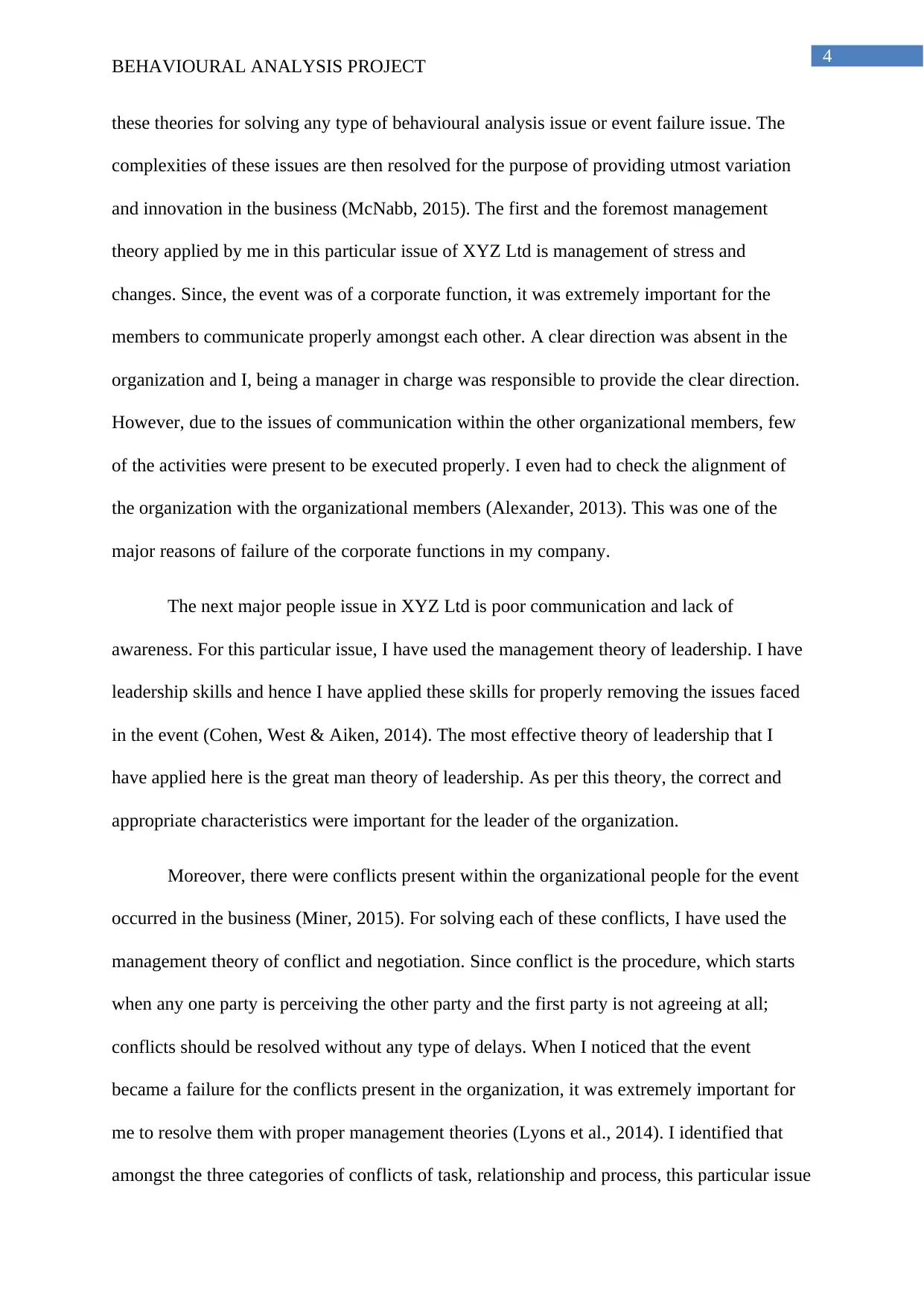
4
BEHAVIOURAL ANALYSIS PROJECT
these theories for solving any type of behavioural analysis issue or event failure issue. The
complexities of these issues are then resolved for the purpose of providing utmost variation
and innovation in the business (McNabb, 2015). The first and the foremost management
theory applied by me in this particular issue of XYZ Ltd is management of stress and
changes. Since, the event was of a corporate function, it was extremely important for the
members to communicate properly amongst each other. A clear direction was absent in the
organization and I, being a manager in charge was responsible to provide the clear direction.
However, due to the issues of communication within the other organizational members, few
of the activities were present to be executed properly. I even had to check the alignment of
the organization with the organizational members (Alexander, 2013). This was one of the
major reasons of failure of the corporate functions in my company.
The next major people issue in XYZ Ltd is poor communication and lack of
awareness. For this particular issue, I have used the management theory of leadership. I have
leadership skills and hence I have applied these skills for properly removing the issues faced
in the event (Cohen, West & Aiken, 2014). The most effective theory of leadership that I
have applied here is the great man theory of leadership. As per this theory, the correct and
appropriate characteristics were important for the leader of the organization.
Moreover, there were conflicts present within the organizational people for the event
occurred in the business (Miner, 2015). For solving each of these conflicts, I have used the
management theory of conflict and negotiation. Since conflict is the procedure, which starts
when any one party is perceiving the other party and the first party is not agreeing at all;
conflicts should be resolved without any type of delays. When I noticed that the event
became a failure for the conflicts present in the organization, it was extremely important for
me to resolve them with proper management theories (Lyons et al., 2014). I identified that
amongst the three categories of conflicts of task, relationship and process, this particular issue
BEHAVIOURAL ANALYSIS PROJECT
these theories for solving any type of behavioural analysis issue or event failure issue. The
complexities of these issues are then resolved for the purpose of providing utmost variation
and innovation in the business (McNabb, 2015). The first and the foremost management
theory applied by me in this particular issue of XYZ Ltd is management of stress and
changes. Since, the event was of a corporate function, it was extremely important for the
members to communicate properly amongst each other. A clear direction was absent in the
organization and I, being a manager in charge was responsible to provide the clear direction.
However, due to the issues of communication within the other organizational members, few
of the activities were present to be executed properly. I even had to check the alignment of
the organization with the organizational members (Alexander, 2013). This was one of the
major reasons of failure of the corporate functions in my company.
The next major people issue in XYZ Ltd is poor communication and lack of
awareness. For this particular issue, I have used the management theory of leadership. I have
leadership skills and hence I have applied these skills for properly removing the issues faced
in the event (Cohen, West & Aiken, 2014). The most effective theory of leadership that I
have applied here is the great man theory of leadership. As per this theory, the correct and
appropriate characteristics were important for the leader of the organization.
Moreover, there were conflicts present within the organizational people for the event
occurred in the business (Miner, 2015). For solving each of these conflicts, I have used the
management theory of conflict and negotiation. Since conflict is the procedure, which starts
when any one party is perceiving the other party and the first party is not agreeing at all;
conflicts should be resolved without any type of delays. When I noticed that the event
became a failure for the conflicts present in the organization, it was extremely important for
me to resolve them with proper management theories (Lyons et al., 2014). I identified that
amongst the three categories of conflicts of task, relationship and process, this particular issue
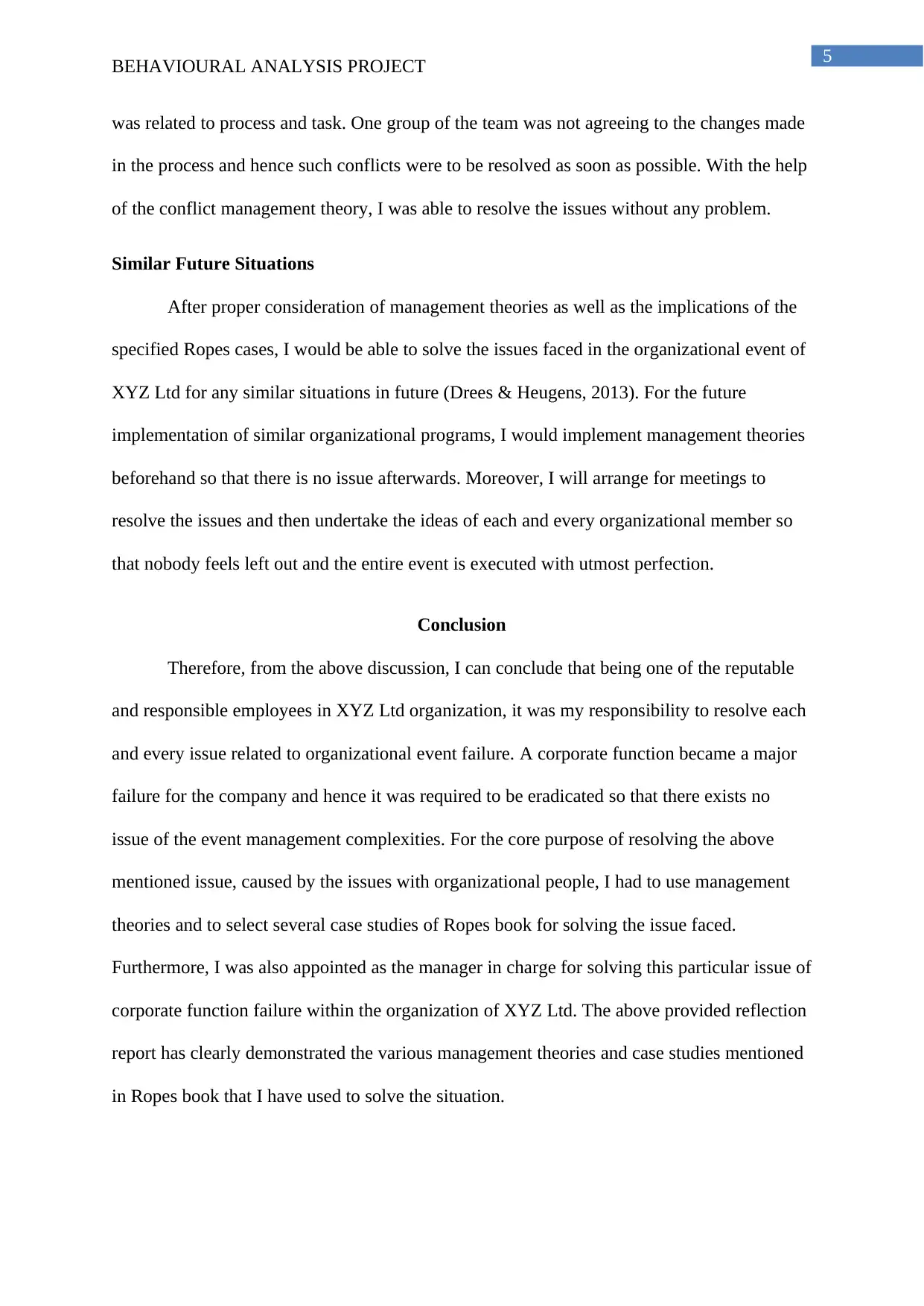
5
BEHAVIOURAL ANALYSIS PROJECT
was related to process and task. One group of the team was not agreeing to the changes made
in the process and hence such conflicts were to be resolved as soon as possible. With the help
of the conflict management theory, I was able to resolve the issues without any problem.
Similar Future Situations
After proper consideration of management theories as well as the implications of the
specified Ropes cases, I would be able to solve the issues faced in the organizational event of
XYZ Ltd for any similar situations in future (Drees & Heugens, 2013). For the future
implementation of similar organizational programs, I would implement management theories
beforehand so that there is no issue afterwards. Moreover, I will arrange for meetings to
resolve the issues and then undertake the ideas of each and every organizational member so
that nobody feels left out and the entire event is executed with utmost perfection.
Conclusion
Therefore, from the above discussion, I can conclude that being one of the reputable
and responsible employees in XYZ Ltd organization, it was my responsibility to resolve each
and every issue related to organizational event failure. A corporate function became a major
failure for the company and hence it was required to be eradicated so that there exists no
issue of the event management complexities. For the core purpose of resolving the above
mentioned issue, caused by the issues with organizational people, I had to use management
theories and to select several case studies of Ropes book for solving the issue faced.
Furthermore, I was also appointed as the manager in charge for solving this particular issue of
corporate function failure within the organization of XYZ Ltd. The above provided reflection
report has clearly demonstrated the various management theories and case studies mentioned
in Ropes book that I have used to solve the situation.
BEHAVIOURAL ANALYSIS PROJECT
was related to process and task. One group of the team was not agreeing to the changes made
in the process and hence such conflicts were to be resolved as soon as possible. With the help
of the conflict management theory, I was able to resolve the issues without any problem.
Similar Future Situations
After proper consideration of management theories as well as the implications of the
specified Ropes cases, I would be able to solve the issues faced in the organizational event of
XYZ Ltd for any similar situations in future (Drees & Heugens, 2013). For the future
implementation of similar organizational programs, I would implement management theories
beforehand so that there is no issue afterwards. Moreover, I will arrange for meetings to
resolve the issues and then undertake the ideas of each and every organizational member so
that nobody feels left out and the entire event is executed with utmost perfection.
Conclusion
Therefore, from the above discussion, I can conclude that being one of the reputable
and responsible employees in XYZ Ltd organization, it was my responsibility to resolve each
and every issue related to organizational event failure. A corporate function became a major
failure for the company and hence it was required to be eradicated so that there exists no
issue of the event management complexities. For the core purpose of resolving the above
mentioned issue, caused by the issues with organizational people, I had to use management
theories and to select several case studies of Ropes book for solving the issue faced.
Furthermore, I was also appointed as the manager in charge for solving this particular issue of
corporate function failure within the organization of XYZ Ltd. The above provided reflection
report has clearly demonstrated the various management theories and case studies mentioned
in Ropes book that I have used to solve the situation.
⊘ This is a preview!⊘
Do you want full access?
Subscribe today to unlock all pages.

Trusted by 1+ million students worldwide

6
BEHAVIOURAL ANALYSIS PROJECT
References
Alexander, K. (2013). Facilities management: theory and practice. Routledge.
Bratton, J., & Gold, J. (2017). Human resource management: theory and practice. Palgrave.
Cohen, P., West, S. G., & Aiken, L. S. (2014). Applied multiple regression/correlation
analysis for the behavioral sciences. Psychology Press.
Drees, J. M., & Heugens, P. P. (2013). Synthesizing and extending resource dependence
theory: A meta-analysis. Journal of Management, 39(6), 1666-1698.
Hill, C. W., Jones, G. R., & Schilling, M. A. (2014). Strategic management: theory: an
integrated approach. Cengage Learning.
Lyons, E. J., Lewis, Z. H., Mayrsohn, B. G., & Rowland, J. L. (2014). Behavior change
techniques implemented in electronic lifestyle activity monitors: a systematic content
analysis. Journal of medical Internet research, 16(8).
McNabb, D. E. (2015). Research methods in public administration and nonprofit
management. Routledge.
Miner, J. B. (2015). Organizational behavior 1: Essential theories of motivation and
leadership. Routledge.
Okajima, I., Nakamura, M., Nishida, S., Usui, A., Hayashida, K. I., Kanno, M., ... & Inoue,
Y. (2013). Cognitive behavioural therapy with behavioural analysis for
pharmacological treatment-resistant chronic insomnia. Psychiatry research, 210(2),
515-521.
Shafritz, J. M., Ott, J. S., & Jang, Y. S. (2015). Classics of organization theory. Cengage
Learning.
BEHAVIOURAL ANALYSIS PROJECT
References
Alexander, K. (2013). Facilities management: theory and practice. Routledge.
Bratton, J., & Gold, J. (2017). Human resource management: theory and practice. Palgrave.
Cohen, P., West, S. G., & Aiken, L. S. (2014). Applied multiple regression/correlation
analysis for the behavioral sciences. Psychology Press.
Drees, J. M., & Heugens, P. P. (2013). Synthesizing and extending resource dependence
theory: A meta-analysis. Journal of Management, 39(6), 1666-1698.
Hill, C. W., Jones, G. R., & Schilling, M. A. (2014). Strategic management: theory: an
integrated approach. Cengage Learning.
Lyons, E. J., Lewis, Z. H., Mayrsohn, B. G., & Rowland, J. L. (2014). Behavior change
techniques implemented in electronic lifestyle activity monitors: a systematic content
analysis. Journal of medical Internet research, 16(8).
McNabb, D. E. (2015). Research methods in public administration and nonprofit
management. Routledge.
Miner, J. B. (2015). Organizational behavior 1: Essential theories of motivation and
leadership. Routledge.
Okajima, I., Nakamura, M., Nishida, S., Usui, A., Hayashida, K. I., Kanno, M., ... & Inoue,
Y. (2013). Cognitive behavioural therapy with behavioural analysis for
pharmacological treatment-resistant chronic insomnia. Psychiatry research, 210(2),
515-521.
Shafritz, J. M., Ott, J. S., & Jang, Y. S. (2015). Classics of organization theory. Cengage
Learning.
1 out of 7
Related Documents
Your All-in-One AI-Powered Toolkit for Academic Success.
+13062052269
info@desklib.com
Available 24*7 on WhatsApp / Email
![[object Object]](/_next/static/media/star-bottom.7253800d.svg)
Unlock your academic potential
Copyright © 2020–2025 A2Z Services. All Rights Reserved. Developed and managed by ZUCOL.




